Connect With Us
Blog
Aging Feet and Falls
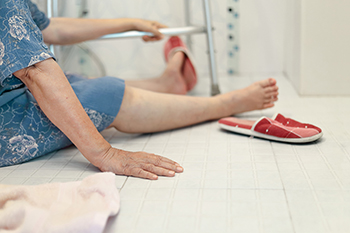
Caring for your feet becomes more important as you age, as feet impact your ability to stay upright and mobile. Research indicates that foot pain, and common issues such as bunions, are significant contributors to falls among older adults. Studies also reveal that foot pain correlates with indoor falls, affecting gait and balance. Addressing foot problems through exercises, proper footwear, and wearing orthotics can reduce fall risks. Simple exercises, like toe rotations and ankle stretches, can strengthen muscles and improve flexibility. Custom-made orthotics and choosing well-fitting shoes, especially for wider or misaligned feet, can help with comfort and balance. If you are a senior and want to prevent falling from injuring your feet, it is suggested that you schedule appointments with a podiatrist. This type of doctor can give you regular examinations and more information on foot care that can enhance mobility, independence, and overall well-being as you age.
Preventing falls among the elderly is very important. If you are older and have fallen or fear that you are prone to falling, consult with Dr. Yeon A. Shim from Roselle Podiatry Group. Our doctor will assess your condition and provide you with quality advice and care.
Every 11 seconds, an elderly American is being treated in an emergency room for a fall related injury. Falls are the leading cause of head and hip injuries for those 65 and older. Due to decreases in strength, balance, senses, and lack of awareness, elderly persons are very susceptible to falling. Thankfully, there are a number of things older persons can do to prevent falls.
How to Prevent Falls
Some effective methods that older persons can do to prevent falls include:
- Enrolling in strength and balance exercise program to increase balance and strength
- Periodically having your sight and hearing checked
- Discuss any medications you have with a doctor to see if it increases the risk of falling
- Clearing the house of falling hazards and installing devices like grab bars and railings
- Utilizing a walker or cane
- Wearing shoes that provide good support and cushioning
- Talking to family members about falling and increasing awareness
Falling can be a traumatic and embarrassing experience for elderly persons; this can make them less willing to leave the house, and less willing to talk to someone about their fears of falling. Doing such things, however, will increase the likelihood of tripping or losing one’s balance. Knowing the causes of falling and how to prevent them is the best way to mitigate the risk of serious injury.
If you have any questions, please feel free to contact our office located in Roselle, NJ . We offer the newest diagnostic and treatment technologies for all your foot care needs.
Signs and Symptoms of a Broken Foot
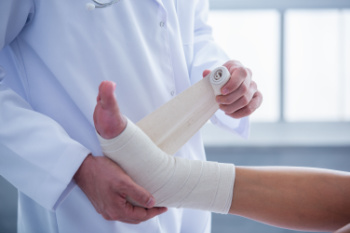 The main symptoms of a broken foot are severe pain, swelling, and bruising around the injured area. Some patients may experience very intense pain when touching or applying pressure to the foot. Difficulty or inability to bear weight on the foot, along with visible deformities or changes in foot shape, can also indicate a potential break. Numbness of the foot is another possible symptom. X-rays or other imaging tests are commonly used to confirm the presence of a fracture. Taking immediate steps to address a potential broken foot can lead to a more effective recovery and prevent complications down the line. If you have a painful foot and suspect a break or fracture, it is suggested that you make an appointment with a podiatrist for an accurate diagnosis and appropriate treatment.
The main symptoms of a broken foot are severe pain, swelling, and bruising around the injured area. Some patients may experience very intense pain when touching or applying pressure to the foot. Difficulty or inability to bear weight on the foot, along with visible deformities or changes in foot shape, can also indicate a potential break. Numbness of the foot is another possible symptom. X-rays or other imaging tests are commonly used to confirm the presence of a fracture. Taking immediate steps to address a potential broken foot can lead to a more effective recovery and prevent complications down the line. If you have a painful foot and suspect a break or fracture, it is suggested that you make an appointment with a podiatrist for an accurate diagnosis and appropriate treatment.
A broken foot requires immediate medical attention and treatment. If you need your feet checked, contact Dr. Yeon A. Shim from Roselle Podiatry Group. Our doctor can provide the care you need to keep you pain-free and on your feet.
Broken Foot Causes, Symptoms, and Treatment
A broken foot is caused by one of the bones in the foot typically breaking when bended, crushed, or stretched beyond its natural capabilities. Usually the location of the fracture indicates how the break occurred, whether it was through an object, fall, or any other type of injury.
Common Symptoms of Broken Feet:
- Bruising
- Pain
- Redness
- Swelling
- Blue in color
- Numbness
- Cold
- Misshapen
- Cuts
- Deformities
Those that suspect they have a broken foot shoot seek urgent medical attention where a medical professional could diagnose the severity.
Treatment for broken bones varies depending on the cause, severity and location. Some will require the use of splints, casts or crutches while others could even involve surgery to repair the broken bones. Personal care includes the use of ice and keeping the foot stabilized and elevated.
If you have any questions please feel free to contact our office located in Roselle, NJ . We offer the newest diagnostic and treatment technologies for all your foot and ankle needs.
Shoe Choices That May Lead to Foot Blisters
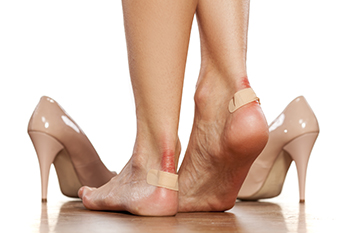
The selection of appropriate footwear plays a pivotal role in maintaining foot health and comfort, yet certain shoe types can inadvertently contribute to the formation of painful blisters. Wearing ill-fitting shoes, characterized by tightness or inadequate space for the toes to move freely, often creates friction and pressure points against the skin, leading to blister formation. High heels, particularly those with a narrow toe box and stiff materials, force the feet into unnatural positions, increasing the risk of blisters on the toes and heels due to constant rubbing and pressure. Similarly, shoes with rough seams, abrasive materials, or poorly cushioned interiors can result in friction and irritation, promoting blister development. Additionally, shoes made from non-breathable materials trap moisture and heat, creating a conducive environment for blister-causing friction and skin irritation. If you are seeking more information about what to look for in shoes that can prevent blisters, it is suggested that you consult a podiatrist who can provide you with useful tips.
Blisters are prone to making everyday activities extremely uncomfortable. If your feet are hurting, contact Dr. Yeon A. Shim of Roselle Podiatry Group. Our doctor can provide the care you need to keep you pain-free and on your feet.
Foot Blisters
Foot blisters develop as a result of constantly wearing tight or ill-fitting footwear. This happens due to the constant rubbing from the shoe, which can often lead to pain.
What Are Foot Blisters?
A foot blister is a small fluid-filled pocket that forms on the upper-most layer of the skin. Blisters are filled with clear fluid and can lead to blood drainage or pus if the area becomes infected.
How Do Blisters Form?
Blisters on the feet are often the result of constant friction of skin and material, usually by shoe rubbing. Walking in sandals, boots, or shoes that don’t fit properly for long periods of time can result in a blister. Having consistent foot moisture and humidity can easily lead to blister formation.
Prevention & Treatment
It is important to properly care for the affected area in order to prevent infection and ease the pain. Do not lance the blister and use a Band-Aid to provide pain relief. Also, be sure to keep your feet dry and wear proper fitting shoes. If you see blood or pus in a blister, seek assistance from a podiatrist.
If you have any questions, please feel free to contact our office located in Roselle, NJ . We offer the newest diagnostic and treatment technologies for all your foot care needs.
Why Live with Pain and Numbness in Your Feet?
Repairing a Torn Achilles Tendon
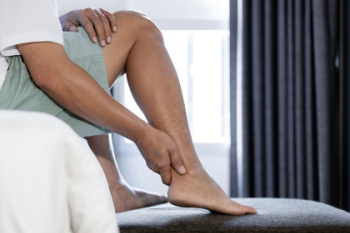
Recovering from a torn Achilles tendon necessitates a strategic approach, wherein the guidance of a podiatrist can prove invaluable. Whether opting for surgical intervention or a non-surgical route, the journey entails careful progression and diligent rehabilitation. Following initial immobilization, facilitated by a plaster cast, the rehabilitation plan, overseen by a podiatrist, emphasizes gradual reintroduction of movement, range of motion exercises, and flexibility work. Surgical interventions similarly involve a period of postoperative immobilization, followed by structured rehabilitation under the supervision of a podiatrist. The anticipated timeline for recovery spans approximately six to nine months. Close monitoring by a podiatrist ensures proper loading of the healing tendon while mitigating the risk of reinjury. Heat therapy, ice application, and flexibility training, all incorporated into the rehabilitation regimen, play pivotal roles in fostering optimal healing. Patience, adherence to the prescribed plan, and collaboration with a podiatrist are needed for achieving successful outcomes and restoring function and strength to the injured tendon. If you have injured your Achilles tendon, it is suggested that you schedule an appointment with a podiatrist for an exam and treatment options.
Achilles tendon injuries need immediate attention to avoid future complications. If you have any concerns, contact Dr. Yeon A. Shim of Roselle Podiatry Group. Our doctor can provide the care you need to keep you pain-free and on your feet.
What Is the Achilles Tendon?
The Achilles tendon is a tendon that connects the lower leg muscles and calf to the heel of the foot. It is the strongest tendon in the human body and is essential for making movement possible. Because this tendon is such an integral part of the body, any injuries to it can create immense difficulties and should immediately be presented to a doctor.
What Are the Symptoms of an Achilles Tendon Injury?
There are various types of injuries that can affect the Achilles tendon. The two most common injuries are Achilles tendinitis and ruptures of the tendon.
Achilles Tendinitis Symptoms
- Inflammation
- Dull to severe pain
- Increased blood flow to the tendon
- Thickening of the tendon
Rupture Symptoms
- Extreme pain and swelling in the foot
- Total immobility
Treatment and Prevention
Achilles tendon injuries are diagnosed by a thorough physical evaluation, which can include an MRI. Treatment involves rest, physical therapy, and in some cases, surgery. However, various preventative measures can be taken to avoid these injuries, such as:
- Thorough stretching of the tendon before and after exercise
- Strengthening exercises like calf raises, squats, leg curls, leg extensions, leg raises, lunges, and leg presses
If you have any questions please feel free to contact our office located in Roselle, NJ . We offer the newest diagnostic tools and technology to treat your foot and ankle needs.
Connecting Gout and Diet
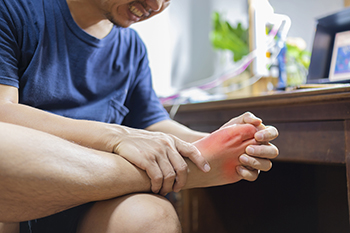
Gout, a form of arthritis notorious for its agonizing pain, stems from the accumulation of uric acid crystals in the joints. While predominantly striking the big toe due to its anatomical distance from the heart, gout can also affect other joints throughout the body. Managing gout often involves navigating dietary choices, particularly purine-rich foods. Organ meats and certain cuts of meat, as well as acidic fare, can worsen symptoms. Lentils, beans, and some plant-based proteins also contain purines, though their impact on gout development remains debated. While gout cannot be cured, its frequency and severity can be managed through a combination of medication and changes to the types of foods you eat. By understanding the intricate interplay between diet and gout, individuals can proactively manage this debilitating condition, enhancing their quality of life and minimizing its disruptive effects. For additional help in reducing the effects of gout, it is suggested that you consult a podiatrist who is trained to treat and manage this condition.
Gout is a foot condition that requires certain treatment and care. If you are seeking treatment, contact Dr. Yeon A. Shim from Roselle Podiatry Group. Our doctor will treat your foot and ankle needs.
What Is Gout?
Gout is a type of arthritis caused by a buildup of uric acid in the bloodstream. It often develops in the foot, especially the big toe area, although it can manifest in other parts of the body as well. Gout can make walking and standing very painful and is especially common in diabetics and the obese.
People typically get gout because of a poor diet. Genetic predisposition is also a factor. The children of parents who have had gout frequently have a chance of developing it themselves.
Gout can easily be identified by redness and inflammation of the big toe and the surrounding areas of the foot. Other symptoms include extreme fatigue, joint pain, and running high fevers. Sometimes corticosteroid drugs can be prescribed to treat gout, but the best way to combat this disease is to get more exercise and eat a better diet.
If you have any questions please feel free to contact our office located in Roselle, NJ . We offer the newest diagnostic and treatment technologies for all your foot and ankle needs.
Wound Debridement
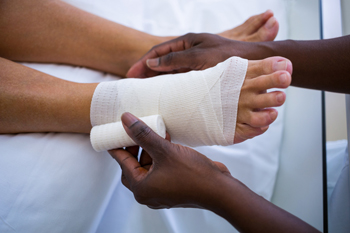
Debridement wound care is often necessary for the proper healing and prevention of complications in foot wounds. Debridement, whether with special dressings, maggots, or mechanical methods, aids in removing dead or infected tissue and facilitates healing. After this procedure, it is important to regularly change the dressing, as per your podiatrist’s instructions. Keeping the dressing dry by avoiding activities like swimming or hot tubs is vital. Always maintain cleanliness by washing your hands before and after touching the wound. Avoid applying pressure and use cushions or crutches, if necessary. While debridement carries potential risks like irritation, bleeding, or infection, its benefits often outweigh these. Pay attention to signs of infection, such as increasing pain, redness, swelling, or fever. If you have foot wounds or have had a debridement procedure and healing is slower than expected or shows signs of infection, it is strongly suggested that you schedule an appointment with a podiatrist for care.
Wound care is an important part in dealing with diabetes. If you have diabetes and a foot wound or would like more information about wound care for diabetics, consult with Dr. Yeon A. Shim from Roselle Podiatry Group. Our doctor will assess your condition and provide you with quality foot and ankle treatment.
What Is Wound Care?
Wound care is the practice of taking proper care of a wound. This can range from the smallest to the largest of wounds. While everyone can benefit from proper wound care, it is much more important for diabetics. Diabetics often suffer from poor blood circulation which causes wounds to heal much slower than they would in a non-diabetic.
What Is the Importance of Wound Care?
While it may not seem apparent with small ulcers on the foot, for diabetics, any size ulcer can become infected. Diabetics often also suffer from neuropathy, or nerve loss. This means they might not even feel when they have an ulcer on their foot. If the wound becomes severely infected, amputation may be necessary. Therefore, it is of the upmost importance to properly care for any and all foot wounds.
How to Care for Wounds
The best way to care for foot wounds is to prevent them. For diabetics, this means daily inspections of the feet for any signs of abnormalities or ulcers. It is also recommended to see a podiatrist several times a year for a foot inspection. If you do have an ulcer, run the wound under water to clear dirt from the wound; then apply antibiotic ointment to the wound and cover with a bandage. Bandages should be changed daily and keeping pressure off the wound is smart. It is advised to see a podiatrist, who can keep an eye on it.
If you have any questions, please feel free to contact our office located in Roselle, NJ . We offer the newest diagnostic and treatment technologies for all your foot care needs.
Plantar Warts Can Be Treated!
Causes of Blackened Toenails

Blackened toenails are caused by repetitive pressure and friction, often occurring when the toe is forced against the front edge of a shoe's toe box. While sometimes referred to as tennis toe, blackened toenails can also affect athletes in soccer, football, squash, racquetball, basketball, running, and skiing. Symptoms include throbbing pain and a reddish-blue or black discoloration of the nail plate due to a subungual hematoma, which is caused by blood under the nail. The big toe is more commonly affected in blackened toenails, but the second toe may also be affected. Wearing ill-fitting shoes plays a pivotal role, causing friction that leads to bleeding under the toenail. In severe cases with significant bleeding, swelling, or infection, visiting a podiatrist is suggested. This foot doctor may relieve pressure on the subungual hematoma by making a small hole in the nail or, in extreme cases, recommend partial or complete nail removal. Prevention involves wearing well-fitted shoes and recognizing early symptoms. Whether you are an avid athlete or enjoy an active lifestyle, if you notice discoloration in the toenails, it is suggested that you schedule an appointment with a podiatrist for treatment solutions.
Toe pain can disrupt your daily activities. If you have any concerns, contact Dr. Yeon A. Shim of Roselle Podiatry Group. Our doctor can provide the care you need to keep you pain-free and on your feet.
What Causes Toe Pain?
Most severe toe pain is caused due to a sports injury, trauma from dropping something heavy on the toe, or bumping into something rigid. Other problems can develop over time for various reasons.
Toe pain can be caused by one or more ailments. The most common include:
- Trauma
- Sports injury
- Wearing shoes that are too tight
- Arthritis
- Gout
- Corns and calluses
- Hammertoe
- Bunions
- Blisters
- Ingrown toenails
- Sprains
- Fractures (broken bones)
- Dislocations
When to See a Podiatrist
- Severe pain
- Persistent pain that lasts more than a week
- Signs of infection
- Continued swelling
- Pain that prevents walking
Diagnosis
In many cases the cause of toe pain is obvious, but in others, a podiatrist may want to use more advanced methods to determine the problem. These can range from simple visual inspections and sensation tests to X-rays and MRI scans. Prior medical history, family medical history, and any recent physical traumatic events will all be taken into consideration for a proper diagnosis.
Treatment
Treatments for toe pain and injuries vary and may include shoe inserts, padding, taping, medicines, injections, and in some cases, surgery. If you believe that you have broken a toe, please see a podiatrist as soon as possible.
If you have any questions please feel free to contact our office located in Roselle, NJ . We offer the newest diagnostic tools and technology to treat your foot and ankle needs.
Lump on the Bottom of the Foot

A lump on the bottom of your foot can lead to discomfort and hinder your daily activities. Among the most common causes of bumps or lumps under the foot are plantar fibromas. These bumps are firm and rubbery nodules that form under the arch. While often painless, plantar fibromas can feel like a stone in the shoe while walking. Calluses, resulting from thickened skin, typically around toes and the ball of the foot, are usually painless and are manageable with proper footwear, creams, and orthotics. Bone spurs, caused by abnormal bone growth due to friction or stress can form hard lumps under the foot. They can be painful, especially during walking, and may require exercises, orthotics, medications, or surgery. Plantar warts, caused by the human papillomavirus, or HPV, result in painful, skin-colored bumps. They respond slowly to treatments like salicylic acid, cryotherapy, or surgery. Additional causes of bumps under the foot include cysts, sesamoiditis, gout, and plantar fasciitis, each requiring specific diagnostic approaches and treatments. If you encounter persistent discomfort or notice a new lump on the bottom of your foot, it is suggested that you schedule an appointment with a podiatrist for an exam and a diagnosis. Treatment options will follow.
Foot Pain
Foot pain can be extremely painful and debilitating. If you have a foot pain, consult with Dr. Yeon A. Shim from Roselle Podiatry Group. Our doctor will assess your condition and provide you with quality foot and ankle treatment.
Causes
Foot pain is a very broad condition that could be caused by one or more ailments. The most common include:
- Bunions
- Hammertoes
- Plantar Fasciitis
- Bone Spurs
- Corns
- Tarsal Tunnel Syndrome
- Ingrown Toenails
- Arthritis (such as Gout, Rheumatoid, and Osteoarthritis)
- Flat Feet
- Injury (from stress fractures, broken toe, foot, ankle, Achilles tendon ruptures, and sprains)
- And more
Diagnosis
To figure out the cause of foot pain, podiatrists utilize several different methods. This can range from simple visual inspections and sensation tests to X-rays and MRI scans. Prior medical history, family medical history, and any recent physical traumatic events will all be taken into consideration for a proper diagnosis.
Treatment
Treatment depends upon the cause of the foot pain. Whether it is resting, staying off the foot, or having surgery; podiatrists have a number of treatment options available for foot pain.
If you have any questions, please feel free to contact our office located in Roselle, NJ . We offer the newest diagnostic and treatment technologies for all your foot care needs.
More...
Definition and Causes of Sever’s Disease

Sever's disease, clinically known as calcaneal apophysitis, is a common heel condition affecting children and adolescents during periods of rapid growth. This condition specifically targets the growth plate in the heel bone, known as the calcaneal apophysis. It occurs when the Achilles tendon exerts excessive tension on the growth plate, leading to inflammation and discomfort. Sever's disease is prevalent among active youngsters involved in sports that entail running and jumping. The bones and tendons in the feet are still developing during this stage, making them more susceptible to stress and irritation. Other contributing factors include inadequate footwear, overuse, and biomechanical issues such as flat feet. Recognizing the signs, which may include heel pain and limping, is essential for early intervention. If your active child has heel pain, it is suggested that you consult a podiatrist who can accurately diagnose and treat Sever’s disease.
Sever's disease often occurs in children and teens. If your child is experiencing foot or ankle pain, see Dr. Yeon A. Shim from Roselle Podiatry Group. Our doctor can treat your child’s foot and ankle needs.
Sever’s Disease
Sever’s disease is also known as calcaneal apophysitis, which is a medical condition that causes heel pain I none or both feet. The disease is known to affect children between the ages of 8 and 14.
Sever’s disease occurs when part of the child’s heel known as the growth plate (calcaneal epiphysis) is attached to the Achilles tendon. This area can suffer injury when the muscles and tendons of the growing foot do not keep pace with bone growth. Therefore, the constant pain which one experiences at the back of the heel will make the child unable to put any weight on the heel. The child is then forced to walk on their toes.
Symptoms
Acute pain – Pain associated with Sever’s disease is usually felt in the heel when the child engages in physical activity such as walking, jumping and or running.
Highly active – Children who are very active are among the most susceptible in experiencing Sever’s disease, because of the stress and tension placed on their feet.
If you have any questions, please feel free to contact our office located in Roselle, NJ . We offer the newest diagnostic and treatment technologies for all your foot and ankle injuries.
Arthritis Can Cause Pain in the Feet and Ankles
Definition and Symptoms of an Achilles Tendon Injury

The Achilles tendon, a strong band of tissue connecting the calf muscles to the heel bone, plays a pivotal role in facilitating movement. An Achilles tendon injury refers to the damage or inflammation that occurs in this critical structure, impacting the ability to walk, run, or perform various physical activities. Typically, injuries to the Achilles tendon manifest as pain, swelling, and stiffness, often concentrated near the back of the heel. Individuals may experience difficulty pointing their toes or pushing off the ground. The discomfort can range from mild to severe, and in some cases, a noticeable thickening of the tendon may be observed. Achilles tendon injuries are frequently associated with overuse, sudden increases in physical activity, or inadequate warm-up routines. If you have endured an Achilles tendon injury, it is suggested that you confer with a podiatrist who can guide you toward the correct treatment method.
Achilles tendon injuries need immediate attention to avoid future complications. If you have any concerns, contact Dr. Yeon A. Shim of Roselle Podiatry Group. Our doctor can provide the care you need to keep you pain-free and on your feet.
What Is the Achilles Tendon?
The Achilles tendon is a tendon that connects the lower leg muscles and calf to the heel of the foot. It is the strongest tendon in the human body and is essential for making movement possible. Because this tendon is such an integral part of the body, any injuries to it can create immense difficulties and should immediately be presented to a doctor.
What Are the Symptoms of an Achilles Tendon Injury?
There are various types of injuries that can affect the Achilles tendon. The two most common injuries are Achilles tendinitis and ruptures of the tendon.
Achilles Tendinitis Symptoms
- Inflammation
- Dull to severe pain
- Increased blood flow to the tendon
- Thickening of the tendon
Rupture Symptoms
- Extreme pain and swelling in the foot
- Total immobility
Treatment and Prevention
Achilles tendon injuries are diagnosed by a thorough physical evaluation, which can include an MRI. Treatment involves rest, physical therapy, and in some cases, surgery. However, various preventative measures can be taken to avoid these injuries, such as:
- Thorough stretching of the tendon before and after exercise
- Strengthening exercises like calf raises, squats, leg curls, leg extensions, leg raises, lunges, and leg presses
If you have any questions please feel free to contact our office located in Roselle, NJ . We offer the newest diagnostic tools and technology to treat your foot and ankle needs.
Athlete's Foot Is a Common Fungal Infection

Athlete's foot, medically known as tinea pedis, is a prevalent fungal infection that affects the skin on the feet, often between the toes. This condition can strike anyone, not just athletes, and is primarily caused by dermatophyte fungi. Athlete's foot thrives in warm, moist environments, making it a common occurrence in areas like locker rooms, swimming pools, and shared showers. The symptoms of athlete's foot typically include itching, burning, and stinging sensations on the affected skin. As the infection progresses, it may lead to peeling, redness, and the development of blisters or cracked skin. In severe cases, the condition can spread to other parts of the foot, including the toenails. Fortunately, athlete's foot is usually easily treatable by visiting a podiatrist who can offer you prescribed medication for relief. If you have developed athlete’s foot, it is suggested that you schedule an appointment with this type of doctor who can guide you toward effective prevention methods.
Athlete’s Foot
Athlete’s foot is often an uncomfortable condition to experience. Thankfully, podiatrists specialize in treating athlete’s foot and offer the best treatment options. If you have any questions about athlete’s foot, consult with Dr. Yeon A. Shim from Roselle Podiatry Group. Our doctor will assess your condition and provide you with quality treatment.
What Is Athlete’s Foot?
Tinea pedis, more commonly known as athlete’s foot, is a non-serious and common fungal infection of the foot. Athlete’s foot is contagious and can be contracted by touching someone who has it or infected surfaces. The most common places contaminated by it are public showers, locker rooms, and swimming pools. Once contracted, it grows on feet that are left inside moist, dark, and warm shoes and socks.
Prevention
The most effective ways to prevent athlete’s foot include:
- Thoroughly washing and drying feet
- Avoid going barefoot in locker rooms and public showers
- Using shower shoes in public showers
- Wearing socks that allow the feet to breathe
- Changing socks and shoes frequently if you sweat a lot
Symptoms
Athlete’s foot initially occurs as a rash between the toes. However, if left undiagnosed, it can spread to the sides and bottom of the feet, toenails, and if touched by hand, the hands themselves. Symptoms include:
- Redness
- Burning
- Itching
- Scaly and peeling skin
Diagnosis and Treatment
Diagnosis is quick and easy. Skin samples will be taken and either viewed under a microscope or sent to a lab for testing. Sometimes, a podiatrist can diagnose it based on simply looking at it. Once confirmed, treatment options include oral and topical antifungal medications.
If you have any questions, please feel free to contact our office located in Roselle, NJ . We offer the newest diagnostic and treatment technologies for all your foot care needs.



